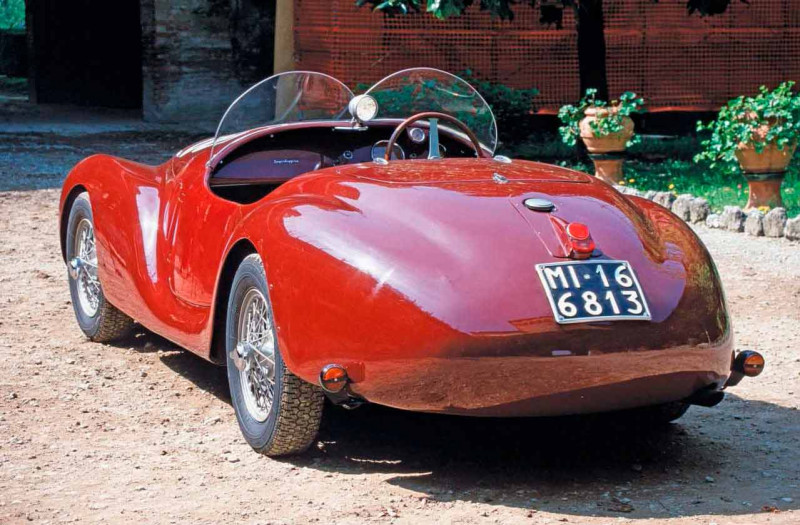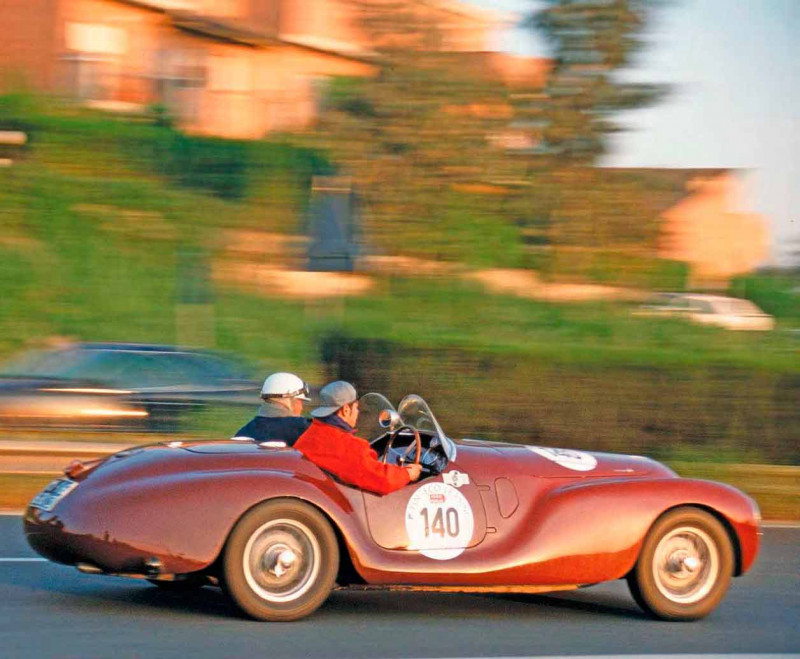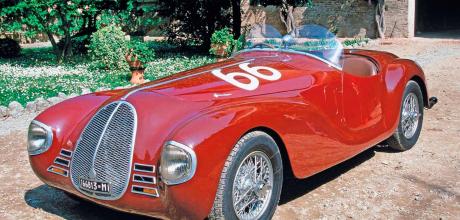1940 Auto Avio Costruzioni 815 - Enzo Ferrari’s first ever car
The amazing story of Enzo Ferrari’s first ever car – why he couldn’t call it a Ferrari, how Ascari came to be his first customer and why the AAC 815 might just be the world’s most valuable car Story by Simon Moore & Peter Collins.
FERRARI ZERO
Auto Avio Costruzioni 815 — Enzo Ferrari’s first ever car
In April 1940, two never-seen-before cars lined up at what passed for the Mille Miglia in that war-torn year. In one of the cars sat an Italian aristocrat; in the other a 21 year-old Alberto Ascari. Although neither car would finish the race, they established something of huge significance: this was the first ever outing of a car created by Enzo Ferrari.

But the new car was not named after Signor Ferrari; it went under the convoluted moniker of Auto Avio Costruzioni 815 (or AAC 815 for short). Enzo had been banned from using his own name in the severance agreement he’d reached with Alfa Romeo, for which he had run Scuderia Ferrari: he was not only banned from competing with Alfa but was also not allowed to use the name Ferrari on a car.
So how did Enzo reach the position of being a car manufacturer with the AAC 815? By his own admission, Enzo Ferrari was not a designer, nor even an engineer; as he said, “I have never thought of myself as a designer or inventor – just an agitator of men.” That’s something of an understatement – his masterful manipulation of people helped bring him tremendous success but also caused considerable antagonism.

Enzo Ferrari started out with a coachbuilding enterprise in Modena but after it went bankrupt, he went to work at Antonio Ascari’s Alfa Romeo dealership in Milan. He raced Alfas and was selected to drive the then-new Alfa Romeo P2 at the French Grand Prix in 1924 but inexplicably left Lyon after practice and failed to start the race. Although he competed in a few minor races and hillclimbs in Italy after that, he essentially gave up front line racing. He then became the Alfa Romeo agent for the region around Modena and in 1929 formed a racing team, Scuderia Ferrari, to assist rich customers with race preparation and organisation.
After Alfa Romeo withdrew its works racing team for financial reasons at the end of the 1932 season, Scuderia Ferrari became the de facto works team, achieving considerable success. Against Mercedes- Benz and Auto Union, team leader Tazio Nuvolari was magnificent, the less powerful Alfas winning several races in 1935 and 1936 before the lack of development at Alfa Romeo left Scuderia Ferrari’s cars uncompetitive.
In 1938, Scuderia Ferrari (by now majority owned by Alfa Romeo) was put into liquidation and Alfa Corse in Milano took over racing activities. Much of the preseason preparation was conducted at the old Scuderia Ferrari premises in Modena, which had always belonged to Enzo Ferrari himself. He was nominally team manager but basically stayed at home in Modena and only visited Milan occasionally.
To add to Enzo’s grumbling about having to commute from Modena to Milan, politics reared its ugly head because Vittorio Jano was pushed out after the 1937 season, moving to Lancia. The new engineer in charge of development in Milan was a Spanish engineer, Wifredo Ricart, who Enzo could not stand and made no bones about it. At every stage he took the chance to make snide remarks and score points; it was a childish and totally unproductive display of behaviour that finally led to Enzo being fired.
Enzo admitted this happened, but many journalists gloss over this period in early 1939. Ferrari wasn’t a wily manipulator for nothing, however. Although his severance agreement with Alfa included a clear ‘no compete’ clause, including a ban on the use of the name Ferrari, he very quickly opened a machine shop in his Modena premises under the name Auto Avio Costruzioni, once he had terminated the lease with Alfa Corse. Before the end of 1939, he had a contract with a Roman company, Compagnia Nazionale Aeronautica, to machine parts for a small four-cylinder aircraft engine.
Enzo invested a considerable sum in top-quality milling machines, lathes and other equipment and business built up well. Then, at the end of 1939, he received a serious request to construct two new sports racing cars capable of competing in the 1940 Mille Miglia race. Somewhat surprisingly, this event took place despite the state of war in Europe. It would not be over the usual route from Brescia to Rome and back, but instead consisted of 10 laps of a 100-mile circuit in the Brescia area, taking in Cremona and almost Mantova.
The request for the new cars had come from Alberto Ascari and a friend of his, a member of one of Modena’s most distinguished families: Marchese Lotario Rangoni Machiavelli di Modena, whose garage was not far up the road from Ferrari’s premises. The decision to build the cars was taken at a dinner on Christmas Eve 1939, which Enzo was attending with other automotive friends from the area – no family get-together for him!
Alberto Massimino, Enrico Nardi and Bellentani were involved in the design. Time was extremely short. From the first pencil line to arrival on the starting grid took less than four months. For convenience the designers used a Fiat 508 Nuovo Balilla as the basis for the new car, which was to race in the up to 1.5-litre class, thus not strictly competing with Alfa Romeo (which was using the larger 6C 2500). An added incentive of using Fiat parts was that the Torinese company was offering cash prizes for class results to any car using its components.
The Fiat 508 was a good choice because it utilised quite advanced techniques for a relatively cheap road car, such as an overhead-valve engine, four-wheel hydraulic brakes, independent front suspension with hydraulic dampers and a rear end suspended on semielliptic springs and hydraulic dampers. Besides, Rangoni was running a Balilla hotted up by local tuner, Stanguellini, as his road car.
The main problem Massimino faced lay under the bonnet. The 508 engine was only a 1.0-litre unit and unsuitable for boring and/or stroking out to 1.5 litres. So he opted for the radical move of getting an aluminium crankcase cast and topping that with two modified Balilla cylinder heads, creating an in-line eight-cylinder engine. As many Fiat parts were used as possible. Auto Avio made the five-bearing crankshaft and the camshaft; the distributors were replaced with a single Marelli unit; a new water pump was made; and the whole thing was fed by four Weber single-choke 30DR2 downdraught carburettors. Bore and stroke of the new engine were 63mm and 60mm respectively, and using a 7:1 compression ratio, the 1496cc engine pushed out 72hp at 5500rpm. It was the engine that gave the new car its name: 815, for eight cylinders and 1.5 litres.
Enzo Ferrari had previously contracted Carrozzeria Touring of Milan to clothe the works Alfas for 1938 and 1939, so he turned to the same coachbuilder to body his new 815. Touring came up with a stylish enveloping shape with integrated wings – quite advanced for the period – and almost a copy, albeit smaller, of Touring’s work on 2.5-litre Alfa Romeos. The covered headlights and elongated tail were designed to improve aerodynamic penetration, while the slits at the front took cooling air to the brakes.
All up weight was a mere 625kg. Initial testing was done on the roads around Modena by Enrico Nardi. The two cars were given the chassis numbers 020 and 021, the former for Rangoni and the latter for Ascari. As soon as the flag dropped for the 1940 Gran Premio Brescia della Mille Miglia, it became clear that the 815s were the quickest in their class, building up a lead of over half an hour before retiring late in the event. At one point they had been first and second, with Ascari ahead of Rangoni. Interestingly, both Autocar and Motor magazines, in their race reports, referred to the cars as Ferraris.
However, the Second World War inevitably led to the two cars disappearing from view for several years. Rangoni’s car moved on to his brother after the death of the Marchese in a bomber aircraft accident but sadly this car was broken up and crushed in 1958. Tragically a similar fate was also to await the Ferrari 125 S, the first true Ferrari ever built.
Ascari’s car (021) passed to Enrico Beltracchini in Milan. It had been thought that his first appearance in the car was on 11 May 1947 at Piacenza (an event that also witnessed the debut of the first Ferrari, the 125 S). However, photographic evidence shows that he actually practised for the race at San Remo in April 1947, although he failed to start the event.
Beltracchini also raced the car at Varese (fourth in the over-1100cc class), Vigevano and Pescara (both DNF). He then sold the car and it never raced again, passing from one owner to another.
The car was eventually fully restored, and while it still boasts its original dark reddish purple colour, its headlamp surrounds were replaced with those from a contemporary Opel. The car is now in the eclectic collection of Mario Righini and can often be seen on display at one of the museums in the Modena area or at the Mille Miglia Museum in Brescia.
In his book, Le Mie Gioie Terribili, Enzo Ferrari devotes just one paragraph to the 815, stating: “The car was not a success, mainly because of the haste with which it had been constructed”. But who could have predicted, that April day in 1940 with war clouds gathering all over Europe, that the 815 would be the precursor to something so much bigger, forming the seeds for the first Ferrari in history, the 125 S?
Today, speculation surrounds the value of this unique machine, the very first Ferrari, even if it was not named after Enzo. In all likelihood, it is the most valuable car in the world, with figures as high as £100 million being mentioned. For ‘Ferrari Zero’, that’s a hell of a lot zeros.
Straight-eight engine may have had only 72hp but the 815 showed great race pace by 1940s standards. Alberto Ascari – seen with his car on the opposite page – was behind the AAC 815 and its Mille Miglia run
TECHNICAL SPECIFICATIONS Auto Avio Costruzioni 815
- ENGINE: 1496cc 8-cyl in-line
- MAX POWER: 72bhp at 5500rpm
- INDUCTION: 4 x Weber 30DR2 carbs
- TRANSMISSION: 4-speed manual, rear drive
- SUSPENSION: Transverse leaf spring (front) Live axle & semi-elliptic springs (rear)
- BRAKES: Drums all round
- TYRES: 5.5x15
- WEIGHT: 625kg
- MAX SPEED: 105mph


